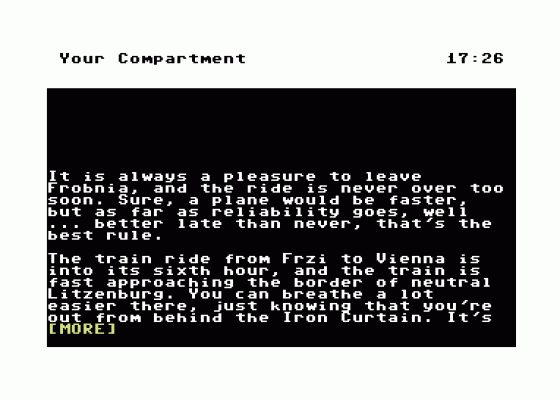
C&VG
 1st April 1988
1st April 1988
Published in Computer & Video Games #78
Border Zone
Border Zone, written by Infocom co-founder and co-author of Zork, Marc Blank, is another departure from Infocom's usual style. Like Nord And Bert, it is split into chapters - three in this case. Also, it has built-in Invisiclues; more on them later. But unlike any previous Infocom adventure, this one is played in real time. That means the clock keeps ticking while you are typing, and while you are thinking between prompts.
The first chapter is set on a train near the border of Frobnia, an eastern bloc country. As an American businessman, you are startled with a man suffering from gunshot wounds staggers into your compartment, shoves a secret document in your hands, and begs you to deliver it to his contact at the border station of Ostnitz. He tells you the recognition phrase, and staggering out, you next see him falling off the roof of the train.
Your job is to get information safely into the hands of the contact, one of the many people on the crowded station platform, when the train arrives at the border. But beware! Your contact will address you in Frobnian. Here is where the Tourists' Guide Book included in the package will become essential - without it you may all too soon hear the words "Oopzi dazi. Ouzna gotcha." (Pardon me. You're under arrest.)

Next you play the American spy who passed the businessman the document. Escaping by jumping off the roof of the train, you now have to cross the border on foot. The plot to this chapter I found to be extremely open, with no real pointers as to which way to approach the problems, and for the first time in an Infocom game, I began to lose interest.
Finally, you get to be a double agent, who passed the documents to the American spy in the first place. The documents concern the assasination of an American ambassador, and you must prevent it without blowing your KGB cover. Here again, the plot is somewhat open, but there are some obvious things to do to keep you going.
Each chapter is a separate adventure, and because of the many fully implemented garden paths along which the player is led, turns out to be staggeringly small once completed.
For example, in chapter three the major problem revolves around concealing the fact that you have the document. There are many combinations of possibilities which may be attempted, most of which will involve a restart. These all have to be tried just to be discounted, before, finally, the actual solution is enacted, and suddenly the affair is over in no time.
Chapter three gives you fifteen real-time minutes to prevent the assassination, which is time for little more than about forty commands. It is necessary to play the chapter a number of times to map it out, before attempting to carry out the quest for real.
The package contains the tourist guide, which is quite an amusing read, and produced in the best Infocom spoof-document style. You get a book of Frobnian Railway matches (absolutely authentic in appearance, and completely non-flammable), a map of the border zone, and a business card, as well as the usual instruction manual, catalogue, special offer card, and disk. The special offer is available from the USA.
There are two game speeds: Fast and Slow, and these may be changed whilst playing, but I didn't find the real-time element added anything to the game - in fact, I found it a pain. Adventures are for thinking through problems, and it is all too easy in Border Zone to act hurriedly and find yourself having to restart as a result. On a C64 (on which I was playing) that is no joke! So, as a result, I often found it necessary to use the PAUSE command, especially in the third chapter, where certain replies have to be carefully read, and notes taken, to deduce the whereabouts of the sniper - it changes every time you play.
And so to the Invisiclues. Type HINT, and a warning is given. Type HINT again, and you get a set of clue headings for the chapter you are currently playing. Select one from the list, and you get a sequence of hints for the chosen problem, in increasing order of helpfulness. The sequence can be started at any time.
The trouble with clues are - they are there! Let's face it, it is all very well saying you don't need to look at them, but the temptation to think "Just this one then..." is all too great - again and again and again! And, of course, the clue headings themselves give quite a lot away, for in them you discover things that you hadn't yet recognised as problems. Nope! I don't like 'em!
The whole package nowhere near approaches the complexity of one single adventure three times the size of one chapter. In fact, it could just as easily have been a three-parter on cassette. Not enough to get your teeth into and settle down comfortably with in the sense that we have come to expect from Infocom adventures.
Scores
Commodore 64/128 Version| Vocabulary | 90% |
| Atmosphere | 80% |
| Personal | 70% |
| Value For Money | 60% |
| Overall | 75% |
Scores
PC (MS-DOS) Version| Vocabulary | 90% |
| Atmosphere | 80% |
| Personal | 70% |
| Value For Money | 60% |
| Overall | 75% |



